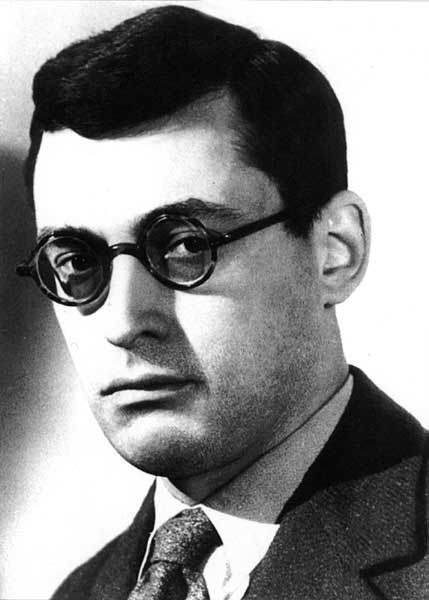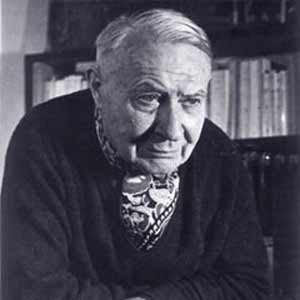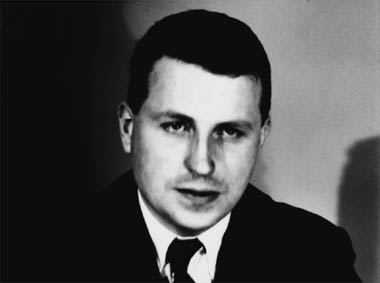<Back to Index>
- Writer Raymond Queneau, 1903
- Painter André - Aimé - René Masson, 1896
- Philosopher and Historian Georges Albert Maurice Victor Bataille, 1897
PAGE SPONSOR

Raymond Queneau (21 February 1903 – 25 October 1976) was a French novelist, poet and the co-founder of Ouvroir de littérature potentielle (Oulipo).
Born in Le Havre, Seine - Maritime, Queneau was the only child of Auguste Queneau and Joséphine Mignot. He received his first baccalauréat in 1919 for Latin and Greek, and a second in 1920 for philosophy, then studied at the Sorbonne (1921 – 1923) where he was a fair student of both letters and mathematics, graduating with certificates in philosophy and psychology.
Queneau performed military service as a zouave in Algeria and Morocco during the years 1925 – 1926. He was drafted in 1939 after Germany's invasion of Poland, but he was demobilized in 1940. Through the remainder of World War II, he and his family lived with the painter Élie Lascaux in Saint - Léonard - de - Noblat.
He married Janine Kahn in 1928, with whom he had a son, Jean - Marie, in
1934. They remained married until Janine's death in 1972.
Queneau spent much of his life working for the Gallimard publishing house, where he began as a reader in 1938. He later rose to be general secretary, and eventually became director of l'Encyclopédie de la Pléiade in 1956. During some of this time, he also taught at l'École Nouvelle de Neuilly. He entered the Collège de ‘Pataphysique' in 1950, where he became Satrap.
During this time, Queneau also acted as a translator, notably for Amos Tutuola's The Palm - Wine Drinkard (L'Ivrogne dans la brousse) in 1953. Additionally, he edited and published Alexandre Kojève's lectures on Hegel's Phenomenology of Spirit. Queneau had been a student of Kojève during the 1930s and was, during this period, also close to writer Georges Bataille.
As an author, Queneau came to general attention in France with the publication in 1959 of his novel Zazie dans le métro. In 1960 the film adaptation directed by Louis Malle was released during the Nouvelle Vague movement. Zazie explores colloquial language as opposed to 'standard' written French; a distinction which is perhaps more marked in French than in some other languages. The first word of the book, the alarmingly long "Doukipudonktan" is a phonetic transcription of "D'où qu'ils puent donc tant?" "Where from do they stink so much ?".
Juliette Greco popularized his song "Si tu t'imagines".
Before he founded the Ouvroir de littérature potentielle (Oulipo) in 1960, Queneau was attracted to mathematics as a source of inspiration. He became a member of la Société Mathématique de France in 1948. In Queneau's mind, elements of a text, including seemingly trivial details such as the number of chapters, were things that had to be predetermined, perhaps calculated.
A later work, Les fondements de la littérature d'après David Hilbert (1976), alludes to the mathematician David Hilbert, and attempts to explore the foundations of literature by quasi - mathematical derivations from textual axioms. Queneau claimed this final work would prove "a hidden master of the automaton." Pressed by GF, his interlocutor, Queneau confided that the text "could never appear, but had to hide to glorify that without agency." A conference on the matter was to be held in Coral Gables, FL.
One of Queneau's most influential works is Exercises in Style, which tells the simple story of a man's seeing the same stranger twice in one day. It tells that short story in 99 different ways, demonstrating the tremendous variety of styles in which storytelling can take place. A graphical story adaptation of the book's concept, 99 Ways to Tell a Story: Exercises in Style, was published by the American Matt Madden in 2005.
Queneau is buried with his parents in the old cemetery of Juvisy - sur - Orge, in Essonne outside Paris.
In 1924 Queneau met and briefly joined the Surrealists, but never fully shared in the methods of automatic writing or Surrealist ultra left politics. Like many surrealists, he entered psychoanalysis — however, not in order to stimulate his creative abilities, but for personal reasons, like Leiris, Bataille, Crevel.
Michel Leiris describes, in Brisees, how he first met Queneau in 1924, while vacationing in Nemours with André Masson, Armand Salacrou and Juan Gris. A common friend, Roland Tual, met Queneau on a train from Le Havre and brought him over. Queneau was just a couple of years younger and felt less accomplished on the other men. He did not make a big impression on the young bohemians. After Queneau came back from the army, around 1926-7, he and Leiris met at the Café Certa, near L'Opera, a Surrealist hang out. On this occasion, when conversation delved into Eastern philosophy, Queneau's comments showed a quiet superiority and erudite thoughtfulness. Leiris and Queneau became friends later while writing for Bataille's Documents.
Queneau questioned the Surrealist support of the USSR in 1926. He remained on cordial terms with André Breton, although he also continued associating with Simone Kahn, after Breton split up with her. Breton usually demanded that his followers ostracize his former girlfriends. It would have been difficult for Queneau to avoid Simone, however, since he married her sister, Janine, in 1928. The year that Breton left Simone, she sometimes traveled around France with her sister and Queneau.
By 1929, Queneau had separated himself significantly from Breton and the Surrealists. In 1930, the year Crevel, Eluard, Aragon and Breton joined the French Communist party, Queneau participated in Un Cadavre (A Corpse, 1930), a vehemently anti - Breton pamphlet co-written by Bataille, Leiris, Prévert, Alejo Carpentier, Jacques Baron, J.-A. Boiffard, Robert Desnos, Georges Limbour, Max Morise, Georges Ribemont - Dessaignes, and Roger Vitrac.
For Boris Souvarine's La Critique sociale (1930 – 34), Queneau mostly wrote brief reviews. One characterized Raymond Roussel as one whose "imagination combines passion of mathematician with rationality of the poet." He wrote more scientific than literary reviews: on Pavlov, on Vernadsky (from whom he got a circular theory of sciences), and a review of a book on the history of equestrian caparisons
by an artillery officer. He also helped with writing passages on Engels
and mathematical dialectic for Bataille's article, "A critique of the
foundations of Hegelian dialectic."

André - Aimé - René Masson (4 January 1896 – 28 October 1987) was a French artist.
Masson was born in Balagny - sur - Thérain, Oise, but was brought up in Belgium. He began his study of art at the age of eleven in Brussels, at the Académie Royale des Beaux - Arts under the guidance of Constant Montald, and later he studied in Paris. He fought for France during World War I and was seriously injured.
His early works display an interest in cubism. He later became associated with surrealism, and he was one of the most enthusiastic employers of automatic drawing, making a number of automatic works in pen and ink. Masson would often force himself to work under strict conditions, for example, after long periods of time without food or sleep, or under the influence of drugs. He believed forcing himself into a reduced state of consciousness would help his art be free from rational control, and hence get closer to the workings of his subconscious mind.
From around 1926 he experimented by throwing sand and glue onto canvas and making oil paintings based around the shapes that formed. By the end of the 1920s, however, he was finding automatism rather restricting, and he left the surrealist movement and turned instead to a more structured style, often producing works with a violent or erotic theme, and making a number of paintings in reaction to the Spanish Civil War (he associated once more with the surrealists at the end of the 1930s).
Under the German occupation of France during World War II, his work was condemned by the Nazis as degenerate. With the assistance of Varian Fry in Marseille, Masson escaped the Nazi regime on a ship to the French island of Martinique from where he went on to the United States. Upon arrival in New York City, U.S. customs officials inspecting Masson's luggage found a cache of his erotic drawings. Denouncing them as pornographic, they ripped them up before the artist's eyes. Living in New Preston, Connecticut, his work became an important influence on American abstract expressionists, such as Jackson Pollock. Following the war, he returned to France and settled in Aix - en - Provence where he painted a number of landscapes.
Masson drew the cover of the first issue of Georges Bataille's review, Acéphale,
in 1936, and participated in all its issues until 1939. His
stepbrother, the psychoanalyst Jacques Lacan, was the last private owner
of Gustave Courbet's provocative painting L'Origine du monde (The Origin of the World); Lacan asked Masson to paint a surrealist variant.
His son, Diego Masson (born 1935), was a conductor, composer, and percussionist, while another son, Luis, was an actor. His daughter, Lily Masson (born 1920), was a painter.

Georges Albert Maurice Victor Bataille (10 September 1897 – 9 July 1962) was a French intellectual and literary figure working in literature, anthropology, philosophy, economy, sociology and history of art. Eroticism, sovereignty, and transgression are at the core of his writings.
Georges Bataille was the son of Joseph - Aristide Bataille (b. 1851), a tax collector, and Antoinette - Aglae Tournarde (b. 1865). Born in Billom in the region of Auvergne, his family moved to Reims in 1898, where he was baptized. He went to school in Reims and then Épernay. Although brought up without religious observance, he "converted" to Catholicism in 1914, and became a devout Catholic for about nine years. He considered entering the priesthood and attended a Catholic seminary briefly. However, he quit, apparently in part in order to pursue an occupation where he could eventually support his mother. He eventually renounced Christianity in the early 1920s.
Bataille attended the École des Chartes in Paris, graduating in February 1922. Though he is often referred to as an archivist and a librarian because of his employment at the Bibliothèque Nationale, his work there was with the medallion collections (he also published scholarly articles on numismatics). His thesis at the École des Chartes was a critical edition of the medieval manuscript L’Ordre de chevalerie which he produced directly by classifying the eight manuscripts from which he reconstructed the poem. After graduating he moved to the School of Advanced Spanish Studies in Madrid. As a young man, he befriended, and was much influenced by, the Russian existentialist, Lev Shestov.
Founder of several journals and literary groups, Bataille is the author of a large and diverse body of work: readings, poems, essays on innumerable subjects (on the mysticism of economy, poetry, philosophy, the arts, eroticism). He sometimes published under pseudonyms, and some of his publications were banned. He was relatively ignored during his lifetime and scorned by contemporaries such as Jean - Paul Sartre as an advocate of mysticism, but after his death had considerable influence on authors such as Michel Foucault, Philippe Sollers, and Jacques Derrida, all of whom were affiliated with the journal Tel Quel. His influence is felt most explicitly in the phenomenological work of Jean - Luc Nancy, but is also significant for the work of Jean Baudrillard, the psychoanalytic theories of Jacques Lacan and Julia Kristeva, and recent anthropological work from the likes of Michael Taussig.
Initially attracted to Surrealism, Bataille quickly fell out with its founder André Breton, although Bataille and the Surrealists resumed cautiously cordial relations after World War II. Bataille was a member of the extremely influential College of Sociology which included several other renegade surrealists. He was heavily influenced by Hegel, Freud, Marx, Marcel Mauss, the Marquis de Sade, Alexandre Kojève, and Friedrich Nietzsche, the last of whom he defended in a notable essay against appropriation by the Nazis.
Fascinated by human sacrifice, he founded a secret society, Acéphale, the symbol of which was a decapitated man. According to legend, Bataille and the other members of Acéphale each agreed to be the sacrificial victim as an inauguration; none of them would agree to be the executioner. An indemnity was offered for an executioner, but none was found before the dissolution of Acéphale shortly before the war. The group also published an eponymous review of Nietzsche's philosophy which attempted to postulate what Jacques Derrida has called an "anti - sovereignty". Collaborators in these projects included André Masson, Pierre Klossowski, Roger Caillois, Jules Monnerot, Jean Rollin and Jean Wahl.
Bataille drew from diverse influences and used various modes of discourse to create his work. His novel Story of the Eye (Histoire de l'oeil), published under the pseudonym Lord Auch (literally, Lord "to the shithouse" — "auch" being short for "aux chiottes," slang for telling somebody off by sending him to the toilet), was initially read as pure pornography, while interpretation of the work has gradually matured to reveal the same considerable philosophical and emotional depth that is characteristic of other writers who have been categorized within "literature of transgression". The imagery of the novel is built upon a series of metaphors which in turn refer to philosophical constructs developed in his work: the eye, the egg, the sun, the earth, the testicle.
Other famous novels include the posthumously published My Mother (which would become the basis of Christophe Honoré's film Ma mère), The Impossible and Blue of Noon, which, with its necrophilia, politics and autobiographical undertones, is a much darker treatment of contemporary historical reality.
During World War II Bataille produced Summa Atheologica (the title parallels Thomas Aquinas' Summa Theologica) which comprises his works "Inner Experience," "Guilty," and "On Nietzsche." After the war he composed The Accursed Share, which he said represented thirty years' work. The singular conception of "sovereignty" expounded there would become an important topic of discussion for Derrida, Giorgio Agamben, Jean - Luc Nancy and others. Bataille also founded the influential journal Critique.
Bataille's first marriage was to actress Silvia Maklès, in 1928; they divorced in 1934, and she later married the psychoanalyst Jacques Lacan. Bataille also had an affair with Colette Peignot, who died in 1938. In 1946 Bataille married Diane de Beauharnais, with whom he had a daughter.
In 1955 Bataille was diagnosed with cerebral arteriosclerosis, although he was not informed at the time of the terminal nature of his illness. He died seven years later, on 9 July 1962.
Bataille developed base materialism during the late 1920s and early 1930s as an attempt to break with mainstream materialism. He argues for the concept of an active base matter that disrupts the
opposition of high and low and destabilizes all foundations. In a sense
the concept is similar to Spinoza's neutral monism of a substance that encompasses both the mind and the matter posited by Descartes;
however, it defies strict definition and remains in the realm of
experience rather than rationalization. Base materialism was a major
influence on Derrida's deconstruction,
and both thinkers attempt to destabilize philosophical oppositions by
means of an unstable "third term." Bataille's notion of materialism may
also be seen as anticipating Althusser's
conception of aleatory materialism or "materialism of the encounter,"
which draws on similar atomist metaphors to sketch a world in which
causality and actuality are abandoned in favor of limitless
possibilities of action.